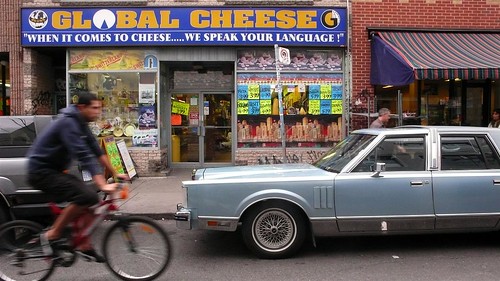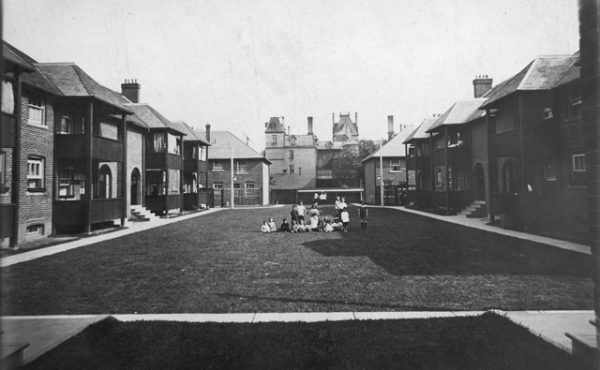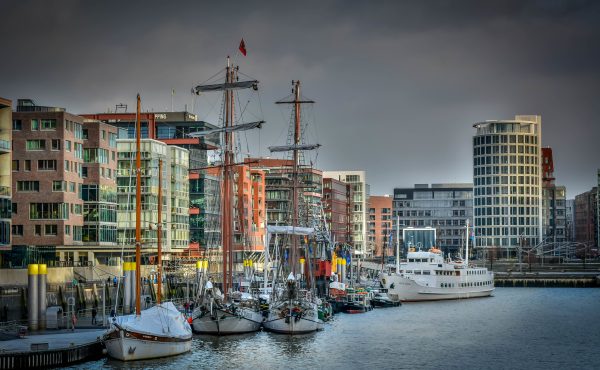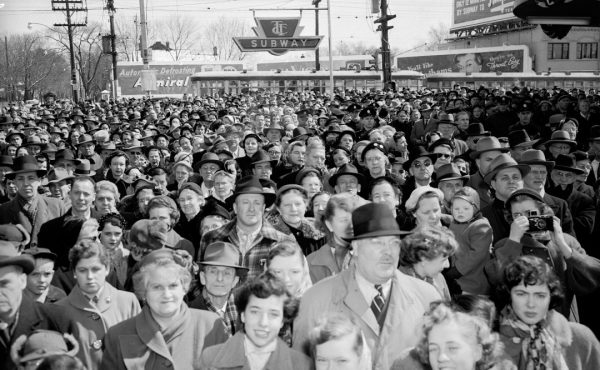
“Why is cycling such a ‘white’ sport?” asks this Monday’s headline on the Guardian’s bike blog. In the article, author Matt Seaton focuses specifically on cycling as a competitive sport, but later in the piece muses on urban cycling, speculating, “even in ethnically diverse inner-city areas, I bet that the vast majority of cyclists you see will be white (and probably middle-class, too — but that’s an issue for another day).”
It is exactly this perception that led U of T planning student Erica Duque to focus her thesis on the topic of ethnicity and cycling in Toronto. “I originally started thinking about it in terms of who cycles in Toronto; I just informally asked people,” says Duque. After these initial conversations showed a pattern in people’s impression of the cycling population as mostly white, Duque decided to pursue this line of questioning further, through an online survey and interviews with the cycling advocacy community. “I wanted to find out who other people thought cycled in Toronto and also get some demographic statistics on who cycled.†It is this relationship between perception and reality that began to form the crux of Duque’s line of thought.
While she faced limitations in getting demographical data that was accurately representative of Toronto’s cycling population, Duque’s survey results (some of which will be released in the upcoming issue of Spacing magazine — out August 25th) did indicate that a majority of people characterize the average cyclist in Toronto as white. This perception rang true across ethnic lines, as survey respondents who identified as white as well as those who identified as visible minority felt this to be the case. International cycling advocate and Executive Director of Mississauga-based organization, Walk and Bike for Life, Gil Penalosa, is unsurprised by this result: “I think they’re right. I think that that’s the perception and in this case I think the perception is reality,” going on to discuss how the cycling population is most likely disproportionately white as compared to Toronto’s overall ethnic make-up.
In a city that liberally boasts its multiculturalism, this is a problem. In a city where bike-lane debates take upwards of 7 heated hours, our municipal representatives duking it out over Toronto travellers’ best interests, this is an even bigger problem.
Suggestions as to why cycling might lack diversity range from simple to complex and multi-layered. Duque and Penalosa present a slew of potential causes, including socio-economic factors, systemic racism, Toronto’s lack of geographically dispersed cycling routes, and the status symbol that the car continues to possess within the “North American dream.”
This summer has seen a step in the right direction, as Culturelink Settlement Services and the Toronto Cyclists Union have teamed up to better battle these cycling inhibitors through concerted outreach to newcomers groups. This partnership is especially important because it has the potential to open up the cycling advocacy community to more diversity. Duque’s thesis showed that the cycling advocacy community may be even more racialized than the overall cycling population, indicating that the environmental movement, which cycling advocacy is often affiliated with, and activist community in general may not “connect with the racial/ethnic communities in the city.”
Penalosa agrees, taking this further to talk about a lack of opportunities for visible minorities not just on the advocacy level, but in community leadership and representation in general. “In the GTA when you meet anybody, within 5 minutes they are telling you how proud they are of how we are the most multicultural city in the world,” Penalosa says. “But in Mississauga, there is not one visible minority in the top 35 decision makers or not one visible minority on the City Council.” Visible minorities make up around 42% of Mississauga’s population.
To borrow from Seaton’s article, quoted above, perhaps that’s an issue for another day. The task at hand at the moment: more accessible education on the benefits of cycling, better effort to build alliances, and a geo-politically dispersed cycling map — all things that the CultureLink/Toronto Cyclists Union outreach campaign is working hard on. Leehe Lev, coordinator of the campaign, has been distributing posters — available in Toronto’s 15 most-spoken languages — to organizations that provide settlement services, cultural festivals, public libraries, and other cultural and community hubs. “It’s been very positive,” says Lev, despite the fact that she was faced with the added challenge of community centres and the City’s cycling department being closed during the strike. The campaign has been extended until October, so that Lev can work on a Toronto cycling handbook, also available in 15 languages.
Lev also hopes to use this time to focus more on the suburbs. Even the briefest glance at the bike map indicates this to be a priority, as bike routes are dramatically absent in the inner suburbs, where immigrant and visible minorities tend to be concentrated. Penalosa envisions a new, revamped cycling map to combat this problem. “In order to get more immigrants and people and everybody cycling is that we need safe bikeways. We need a grid. A safe bikeway is one that is physically separating the cyclists from the cars. All of the things that they city is doing — painting the lines — that’s a waste of money… We need to build a grid.”
Hope is high on this front. “I’ve only been [working on the campaign] for three months, so I haven’t been able to implement that much change,” says Lev. “But it’s happening, it’s going to happen, it’s going to take a domino effect once we’re beyond the pilot stage of this project.”
Photo by antenne




29 comments
In the inner city, there is on-street parking. That means when vehicles are parked, there is usually enough extra space between the parked vehicle and the dotted lane markings. Bicycles use that space to maneuver.
In the suburbs, there is usually no on-street parking. That means motor vehicles use the curb lane to drive on. A bicycle can be squeezed off the curb lane, especially by bigger vehicles (ie. trucks), as well as the higher speeds in the more suburban roads.
This is the most moronic thesis for an article I have read in some time.
Systemic racism playing a part in non-whites cycling?
As a non-white cyclist, who does most of his cycling downtown, I have never noticed a dearth of non-white riders.
What kind of person would even notice this?
Nor did I experience any “systemic racism” at the bike store when I purchased my bike.
Furthermore, I have never been pulled over on my bike for Driving a Bike While Not Being White (DBWNBW).
You might want to do another survey on people who play badminton, frisbee, beach volleyball, picnic, go to gyms, fly kites, shoe-shop, drink wine or something else where you can find “systemic racism” lurking in the weeds.
You must just be trying to stir up reaction for thinking this topic would be worth the effort of putting fingers to keyboard.
I guess it worked.
Can’t say I found the story particularly interesting or compelling though.
There goes 5 minutes of my life I will never get back.
You may have nailed it with “the status symbol that the car continues to possess within the “North American dream.†That “middle class” issue is likely to be more significant than ‘whiteness’, IMHO.
I am intrigued by this in the context of the “three cities” view of Toronto. Is it necessary (or even possible) to figure out whether there is some relationship between the typical destination pattern of various parts of the city, the diversity of the population, and the degree to which bike usage for comparable areas (in terms of types of destinations) has a similar (or not) diversity factor?
The length of a commute and the degree to which facilities are provided (if any), let alone the sensitivity (or not) of motorists in various areas to cycling work against this mode in many areas as has been pointed out here before.
I’m not sure that the “car as the North American dream” really explains the situation as much as the origin/destination patterns of commuters subdivided by race. That would make a fascinating chart, and would likely reinforce some other work that has been done on economic ghettos.
Another comoparison would be an O/D map of students at major universities like UofT, Ryerson and York, subdivided by campus. Cross-referencing this against transportation mode would probably co-relate quite nicely with the availability or suitability of transit, cycling, etc., as the commute to school mode.
Cyclists in Toronto are rude, arrogant, dangerous to themselves and to pedestrians, and ignorant of the laws that apply to them. How can we encourage the existing cyclists to grow up before we encourage new-comers to join them?
I have the exact opposite reaction to the comments above form Earthjuice and Joseph.
First, Joseph: you are so off the mark. Yes, there are a few riders who are as you described, but lumping every cyclist into the same category is next to ridiculous. Its like saying all cops are racially profile, all drivers want to run over pedestrians and cyclists, or all Chinese are good at math. We know these not to be truths, just preconceived stereotypes that are never based on fact.
To Earthjuice: read the article, it says there could be systemic problems getting a diversity into cycling advocacy. I think this is especially true as the old urban core has reverted to some extent to being white, while the burbs are growing with all types of newcomers. Cycling advocacy and culture exists where bikes are and that’s currently downtown. The parts of the city most in need of cycling infrastructure is in the burbs. I think it is always good to examine these issues; if you don’t like it ignore it instead of shitting on the idea.
There is no shortage of Chinese cyclists around Dundas & Spadina.
“White” is not an ethnicity…but a term covering people who come from a range of ethnicities, including many people from the Middle East (who often get referred to as being a distinct race). Bugs the hell out of me when people use “race” and “ethnicity” as interchangeable terms.
Even if it is true that the cycling population is disproportionately white, saying they are “white” is saying very little unless one is looking into their socio-economic characteristics. If you broke it down that way, I’m sure you’d see that there are certain types of “whites” who are also disproportionately represented.
As for “immigrants” being under-represented in the cycling population, this doesn’t seem to be much of a mystery when you look at settlement patterns. Stats tend to show that immigrants tend to settle initially in the city of TO (when they are more economically unstable), then move out to the inner and more likely outer suburbs as they become more prosperous. And of course, cycling (to work or elsewhere) tends to make less sense in these areas than it does in the inner city with its higher density.
Why do immigrants tend to move to more outlying areas? Probably has something to do with the cost of housing in the inner city, and the fact that roomier homes (which is often what immigrants living in extended family situations want) tend to be less expensive outside the inner city.
I think the last part of the article makes the most sense. Most of our visible minorities live in the suburbs and from what I’ve heard from people who used to live there, cycling is scary. I’ve also noticed that black people tend to be slightly more likely to ride on the sidewalk downtown, although they will do it much slower than a white guy who feels that sidewalks don’t have speed limits (and they don’t, because they’re for WALKING).
To look at this realistically, downtown Toronto is becoming demographically whiter. The suburbs are becoming less so. Ergo, inner city cyclists are more likely to be white. If visible minorities aren’t cycling, it probably has less to do with “racism” and more to do with the fact that most suburbanites don’t cycle except for leisure, regardless of race/ethnicity. Even if the suburbs were covered in safe bike routes, people wouldn’t use them much simply because the distances involved in getting from one place to another would be impractical.
But I definitely think it’s possible that the idea of the car as a desirable symbol of North American life has something to do with a reluctance to cycle on the part of new immigrants. But I don’t really think racism has much to do with it. But I could be wrong…
Funny how this post and the responses thus far haven’t raised the rather obvious spectre of Christian Lander looming over the overall thesis…
I agree with EarthJuice, I don’t see systemic racism in the cycling community.
We shouldn’t second guess our motives for wanting better and safer bike infrastructure for everyone.
I’m sort of disappointed in some of the negative comments posted here, however, you now expect this unreasoned vitriol with every discussion of cycling. A few thoughts…
This is one of the ethnic observations in Toronto we aren’t comfortable talking about. Is is political correctness? My thought is, the downtown population, where cycling is feasible regularly, is mostly white. The inner suburbs, on comparison, definitely aren’t white.
A whole bunch of cultural factors come into play. Biking to work might be perceived as lower-class in status-oriented ethnic communities. Paradoxically, owning a bike is also a luxury item (while a car might be a necessity) if you are just making ends meet. Riding a bike to work is a luxury in terms of time… I know I can’t do it as much as I’d like. If you are in the suburbs your job and child care arrangements are less likely to accommodate biking.
Add this that you’d have to have a death wish to ride to work in somewhere like Markham where there are lots of jobs (and a high degree of ethnicity). I think this author raises a good point but the reasons for the divide are subtle.
Another issue I forgot to mention is that people outside of downtown have a higher need for a car for things that they simply cannot do by cycling. Therefore, they are probably likely to have a higher rate of car ownership relative to many other factors. It’s a short step from owning a car to using it as your primary mode of transport even if a bike might be “better”.
Lurking behind the entire debate is the general question of advocacy and the issues that matter to various populations. People fight for what they need whether this is a hard infrastructure thing like bike lanes, or a softer topic such as better parks and playgrounds both for amusement, for community gatherings and for social spinoffs like giving kids enjoyable places to hang out.
Separate from the question of engaging a wider variety of people in advocacy is the question of what matters to them, what are their issues. I am sure it would be possible to find very different demographics among advocates for other issues depending on the makeup of the groups who find these important.
The fact that the word “hipster” nowhere appears here is a problem.
And not in the derogatory us vs. them kind of way. Hipster bashing is so passé. Own the term. It’s okay to be a hipster.
But I think we would be remiss to leave out the hipster’s contribution to cycling culture.
I suspect that another factor at play is occupation type. Keep in mind that visible minorities are more likely to be employed in jobs that require physical activity – blue-collar or not (so I’m including nurses and other health care staff as well). I’d imagine that many people with physically demanding jobs wouldn’t be keen on having a physically demanding commute. Also, if they perceive cycling to be a risky form of transportation, they may shy away from it for fear that an injury would prevent them from being able to work moreso than it would an office worker.
I would like to point out Steve Munro’s comments; they seem particularly clear-minded.
There’s only so many activists, in any given community. Other people just choose to get on with their life, or don’t have the ‘luxury’ of showing up at city meetings and getting involved. Perhaps people who aren’t white have bigger fish to fry than cycling?
Kevin, are you saying that hipsters are a unique racial/ethnic community?
I’d agree with many comment above, that the main reason is economical. Downtown core is becoming whiter and whiter, while cycling outside the downtown core is generally a non-starter, and it probably won’t change too much even if we put more bike lanes in the bulb. Things are just too far apart to make cycling a reasonable choice for many, especially when parking is abundant.
I think there is one more thing that contributes to the issue: for people coming from places where cycling is mainstream, e.g., Beijing, cycling in Toronto looks rather suicidal. Streets are narrow, cars travel fast, even the bike lanes here look like a joke (by comparison, in Beijing, most major streets have dedicated, physically separated bike lanes, many as wide as a car lane here). Many immigrant cyclists just take a quick look at the streets and retreat into their cars, never look back.
This is a total non-issue. Just because we live in multicultural city doesn’t mean every group should have proportional representation in every facet of city life. DIVERSITY, remember? Indians dig cricket more than Chinese. Should we start a program to get more Chinese into cricket?
Ah, but cycling is more important than cricket! Cricket is just a game, but cycling is a progressive, conscious, righteous lifestyle!
So isn’t this really about telling people what to do? There is more than a little whiff of paternalism in the idea that “newcomers” need to be “educated” about benefits of cycling. I mean, in India and China, the two largest source countries for immigrants to Toronto, bike riding is far more common than here. What are we telling them that they don’t already know?
“Kevin, are you saying that hipsters are a unique racial/ethnic community?”
“Hipsters”, or those that use bikes as an accessory foremost, make up only a small percentage of those whoa re “white” and ride. But they want to feel important so they make silly comments like this.
I think what is more accurate to look at (from Kevin’s perspective) is age, not social/fashion status. It is certainly true that those 18-35 seem to ride more than any other demographic. But these people are made of of every social and economic background: lawyers, receptionists, enviro geeks, poor, etc.
As someone who has respected the fun work Newmindspace has done in TO, I’m saddened by Kevin’s suggestion to discuss hipsters, in an article about ethnicity, because it shows how misguided he can sometimes be, especially when he’s living far-off in NYC. Next thing you’ll know he’ll be declaring Adam Vaughan is waging a war on hipsters too.
Mike,
maybe we can tell them (I am not where I stand, I am both we and them:) cycling in Toronto really isn’t as dangerous as it looks. There is a reasonably safe way to ride a bicycle in Toronto (at least in downtown core). And if some of them can join the chorus in demanding better cycling infrastructure, then there is a better chance that cycling can move from fringe into mainstream in Toronto.
James’ comment: “I’m sort of disappointed in some of the negative comments posted here, however, you now expect this unreasoned vitriol…”
James, am wondering what you meant by this.
@samg … Every discussion of biking includes comments like Earthjuice and Joseph Kelly above. It is tiresome.
I’d already obliquely referred to the white/hipster element with my Christian Lander name-drop.
biking in downtown isn’t dangerous, it only LOOKS dangerous from inside a car. as someone who grew up in the outer suburbs, and became a cyclist downtown later on, i can easily say that downtown toronto is one of the safest and efficient places to cycle in all of Ontario (in terms of using cycling as a form of real transportation, rather than as a source of sunday entertainment).
and you get everywhere way faster, too!
there are alot of different kinds of white people. jewish people, french people, irish people, theyre all significantly culturally different, and they look different. so its not really fair to lump them all together. its kind of like when people call japanese people chinese. its just not right, and its rude and unscientific! and what about the mixed race cyclists?
What a stupid article. “Studies” that purport to reflect people’s perceptions should not be used to prove something as fact. I see all kinds of people cycling downtown everyday.
Why does Spacing occasionally fret about this or that being too white when, as far as I know, everyone at Spacing is pretty much white? Why don’t you hire some non-white writers to cure your PC angst? I like Spacing very much but sometimes the perspective is a bit precious.
Thanks for sending us Spacing Toronto Summer-Fall 2009 issue that we purchased after starting up our company subscription for this magazine.
It is a serious challenge to find a full hard copy of this magazine in libraries. I’m just letting all folks here know that the online version is just select articles not all.
We needed to see Emma Feltes fuller article in the above issue. Her work has been referenced on an article that we published:
http://thirdwavecyclingblog.wordpress.com/2009/12/12/bilingual-multilingual-bicycle-maps-canada%e2%80%99s-first-chinese-english-bicycle-map-for-metro-toronto-a-legacy-of-eugene-yao-community-and-cycling-activist/
It is unfortunate that public wide access to full issues of all articles for Spacing Magazine versions is very difficult to get in other large (never mind, small) Canadian cities. It creates blinkers of broader understanding and knowledge sharing for urban and transportation planning issues on other regions in Canada at a practical level, outside of academic journals.
Meanwhile best of luck. Keep up the work!
Jean Chong
Blogmaster & Editor
Third Wave Cycling Group